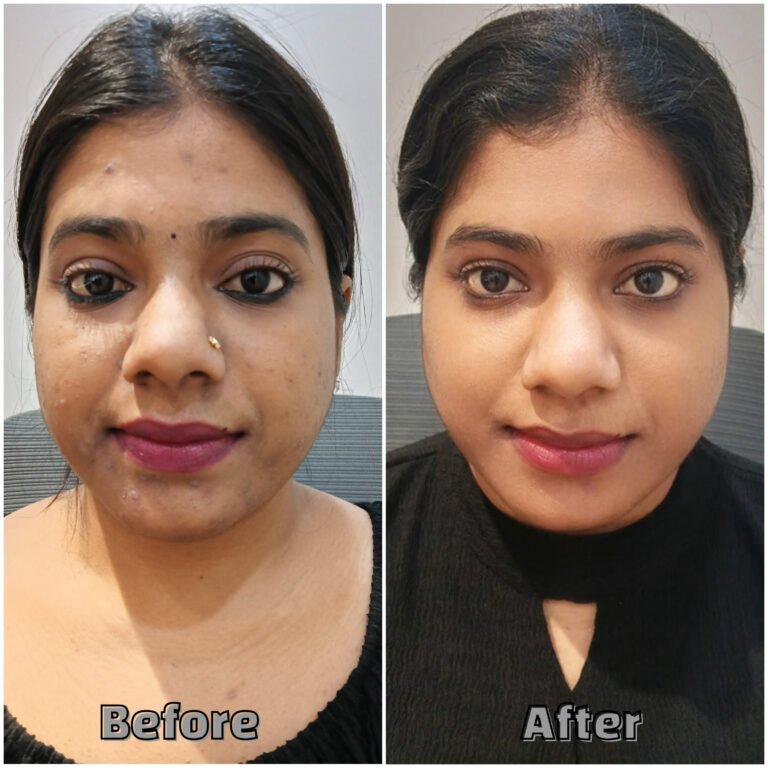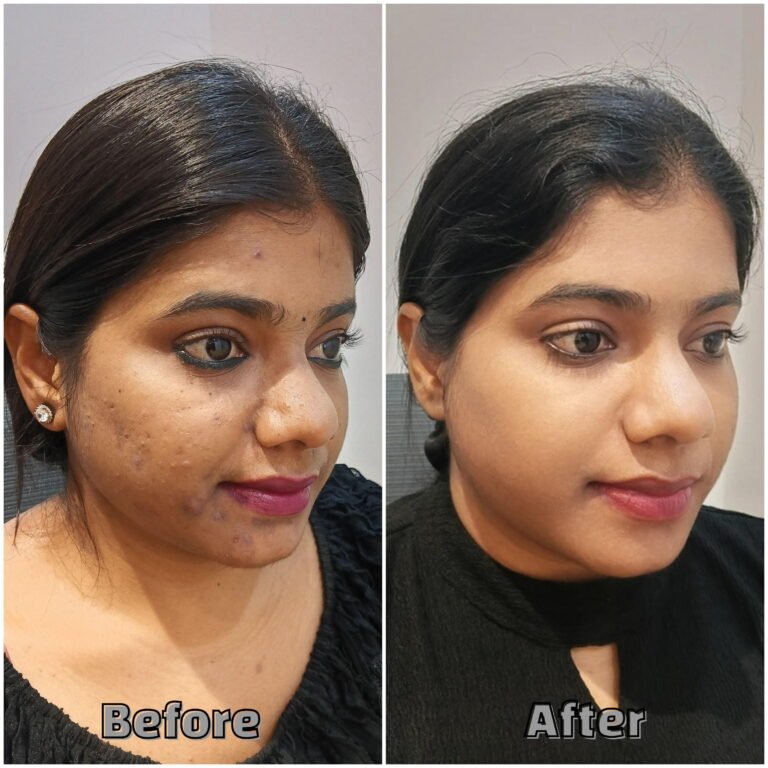Pimple Treatment in Bangalore
"Unlock the flawless canvas of your dreams – say goodbye to acne and scars, and hello to confidence in every reflection!"
Acne, with its relentless appearance, often feels like an uninvited guest overstaying its welcome. Beyond just physical blemishes, it weaves its way into the fabric of our lives, impacting us on multiple levels. From the moment we wake up to the scrutiny in the mirror, acne casts a shadow over our self-esteem, dictating how we perceive ourselves and how others perceive us. It’s not just about the occasional breakout; it’s the constant battle against stubborn spots, the frustration of failed treatments, and the lingering scars that serve as unwelcome reminders. Acne isn’t just a skin condition; it’s a mental and emotional burden, influencing our social interactions, our confidence in professional settings, and even our intimate relationships. It shapes the way we dress, the makeup we apply, and the opportunities we seize—or shy away from. But amidst the struggle, there’s hope. By addressing acne head-on with effective treatments, we reclaim control over our skin and, by extension, our lives. It’s not just about achieving clear skin; it’s about regaining the freedom to live confidently, authentically, and unapologetically.
Professional and Home Care for Active Acne
Doctor’s Consultation:
- A crucial first step involves consulting a dermatologist or skincare professional who specializes in treating acne. They will assess the severity of your acne, identify potential triggers, and recommend suitable treatment option.
Prescription Medications:
- Depending on the type and severity of acne, the dermatologist may prescribe topical medications such as retinoids, benzoyl peroxide, or antibiotics to reduce inflammation, unclog pores, and kill acne-causing bacteria.
- Oral medications like oral antibiotics, hormonal therapy (for hormonal acne in females), or isotretinoin may also be prescribed for more severe cases of acne.
In-office Procedures:
- Doctors perform in-office procedures like chemical peels, subcission and dermal fillers, laser therapy to accelerate acne healing, reduce acne scars, and improve overall skin texture.
Regular Follow-ups:
- It’s essential to follow up with your doctors regularly to monitor your progress, adjust medications if necessary, and address any concerns or side effects.
Home Care for Active Acne Treatment:
Gentle Cleansing:
- Cleanse your face twice daily with a gentle, non-comedogenic cleanser to remove excess oil, dirt, and impurities without stripping the skin of its natural moisture.
Topical Treatments:
- Apply topical acne treatments as prescribed by your dermatologist, such as benzoyl peroxide, salicylic acid, or retinoids, to target acne lesions, reduce inflammation, and prevent new breakouts.
Moisturization:
- Use a lightweight, oil-free moisturizer to hydrate the skin without clogging pores. Moisturizing is essential, even for oily or acne-prone skin, as it helps maintain the skin’s barrier function and prevents excessive dryness.
Sun Protection:
- Apply a broad-spectrum sunscreen with SPF 30 or higher daily, even on cloudy days, to protect your skin from harmful UV rays. Some acne treatments, such as retinoids, can increase sun sensitivity, making sun protection crucial to prevent sunburn and further skin damage.
Avoiding Irritants:
- Minimize exposure to potential irritants and comedogenic substances, such as heavy makeup, harsh skincare products, and oily or greasy cosmetics, which can exacerbate acne and clog pores.
Healthy Lifestyle:
- Maintain a healthy lifestyle by eating a balanced diet, staying hydrated, getting enough sleep, and managing stress levels, as these factors can influence acne development and severity.
By combining professional care with diligent home care practices, individuals can effectively manage and treat active acne, leading to clearer, healthier skin over time.
A. Globally, pimples is a widespread, chronic inflammatory condition of the pilosebaceous follicles. They is not fatal, but depending on its severity, it can leave the sufferer with scars, irritation, and significant psychological effects.
The following elements are thought to be relevant in the classical aetiology of pimples. Genetics, environmental variables (temperature, pollution, humidity, sun exposure, mineral oils/halogenated hydrocarbons), nutrition, hormonal state, stress, smoking, comedogenic medicines such as androgens, halogens, corticosteroids, bacteria, and cosmetics may cause, worsen, or exacerbate pimples.
A. Amongst the available treatment options for pimples primary objective is to manage and treat existing lesions by controlling the sebum secretion, abnormal hyperkeratinization of the pilosebaceous follicles and propionibacterium infection. As a result, the main treatment options include anti-inflammatory drugs and antibacterial drugs administered either through topical or systemic or oral route of administration.
Tailoring acne treatment should indeed take into consideration the severity of the acne.
- Mild Acne Vulgaris – Topical Retinoids, Benzoyl Peroxide, Topical Clindamycin, Topical Erythromycin, Azelaic Acid, Topical Salicylic Acid
- Moderate-to-Severe Acne Vulgaris- Oral Isotretinoin, Oral Antibiotics, Oral Hormonal Therapies
Topical treatments
- Retinoids
- Antibiotics
- Combinational topical treatments
Systemic treatments
- Retinoids
- Antibiotics
- Hormonal treatments
A. Give an acne treatment at least 4 weeks to work. Acne treatment needs time to work. If a treatment works for you, you should notice some improvement in 4 to 6 weeks. It can take two to three months or longer to see clearing. If you notice improvement, keep using the treatment. Even when you see clearing, you’ll want to keep using the acne treatment. This helps to prevent new breakouts.
If you don’t see improvement after 4 to 6 weeks, add a second acne product to your treatment plan.
This approach can help attack the different causes of acne. Bacteria, clogged pores, oil, and inflammation can all cause acne.
Of course, the second treatment should attack a different cause of acne. For example, if you are using an acne treatment that contains benzoyl peroxide, the second acne treatment should contain another acne-fighting ingredient. To help you select another product, here’s what the different active ingredients work on:
- Benzoyl peroxide decreases P. acnes bacteria
- Retinoids, such as adapalene gel, unclog pores and reduce oiliness
- Salicylic acid eases inflammation and unclogs pores
A. Pimple treatment is generally safe for sensitive skin. You need to visit your doctor to understand your skin type and the kind of pimple, its periodicity and other related factors causing pimples to prescribe the right treatment and products suitable for the same.



